- LED components vary from each other during production. This is because of acoating process which creates significant variations that impact the lumens, color temperature and voltage of LEDs. Even within the same production batch, quite large differences can be noticed.
- The binning of LEDs means they are measured on a variety offactorsviz.lumens, color temperature, voltage etc.Measurement data is divided into classes, which we call bins, and the LED components are divided accordingly. To maximize yield LED manufacturers,sort their production into lumen, color and sometimes voltage bins. This results in batches of LEDs that haveonly the slightest deviations in performance from one another. Luminaire manufacturers can then easily select the bin (or set of bins) that best meets their requirements.
- The two most critical bin criteria that impact LED performance are:
- 1.Lumenoutput: LEDs are individually measured and sorted by lumen output into prescribed ranges.
- 2.Color temperature: Color temperature bins are defined by (x,y) co-ordinates on the Chromaticity Diagram. The larger the bin size, more the variation in the color temperature and vice versa.
- Accepting or using LEDs from a wide range of bins substantially increases the variability of luminaire performance creating high probability for negative impact to the end users.
- Hence choosing LEDs from the correct bin is key to superior product performance.
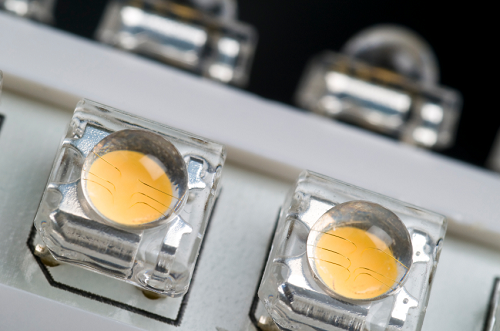
|
Classification of Roads (BIS, 1981) |
||||||
|
Sr. No |
Road |
Class of Road |
Req. Avg. Lux (lx) |
Uniformity |
Road Details |
|
|
1 |
Main Road |
A1 |
30 |
0.4 |
A1: For very important routes with rapid and dense traffic where the only considerations are the safety and speed of the traffic |
|
|
2 |
Main Road |
A2 |
15 |
0.4 |
A2: For main roads with considerable mixed traffic like main city streets, arterial roads, and thoroughfares |
|
|
3 |
Secondary Road |
B1 |
8 |
0.33 |
B1: For secondary roads with considerable traffic such as local traffic routes, and shopping streets |
|
|
4 |
Secondary Road |
B2 |
4 |
0.33 |
B2: For secondary roads with light traffic |
|
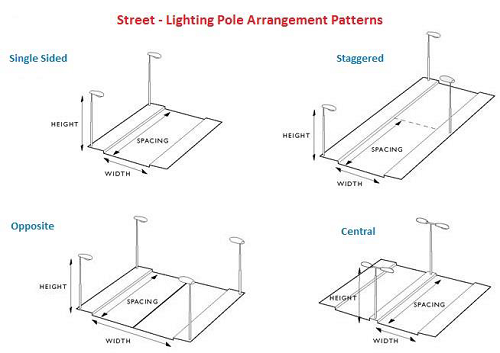
- Lumens (lm) is a measurement unit, which tells the total amount of light emitted from a light source such as a bulb, tube light, street light, flash light etc.
- On a broad level it can be said that more the Lumens the brighter the light.
- If "more lumens" are concentrated in one area, the area illuminated will be lesser but lux in the illuminated area will be higher. If "more lumens" are distributed/spread in a large area, the area illuminated will be more but the lux achieved in the illuminated area will be lesser.Ref. Pic. 2
- Lumens is measured in a photometry lab, using either an Integrating Sphere or a Photo-goniometer.
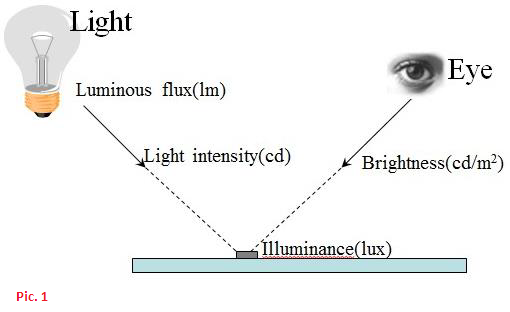
- Lux(lx)is used to measure the amount of light output in a given area -one lux is equal to one lumen per square meter.
- It enables us to measure the total "amount" of visible light present and the intensity of the illumination on a surface.
- Lux is an efficient measurement for determining what we see as the brightness of a beam. Ref. Pic. 1
- If the light output is focused on a small area, we see this as very bright light. If the light output is spread in a wide beam over a greater area, we experience this as a weaker light.
- Lux is measured using a Lux Meter which is usually a hand held device.
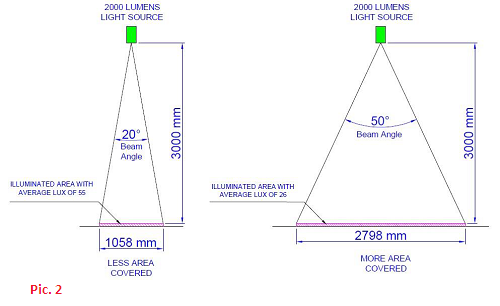
- It is wrong to assume that 100% of the light output from the light source is used up. Part of the total light output (lumens) from the light source is wasted and part of it is used. The part that is used is called/considered Useful Lumens.
- When a conventional lamp, say a Sodium Vapour bulb is placed in a fitting (or luminaire) losses of light will occur –this is because the bulb radiates light in all directions. Therefore, a great deal of the light is lost because it goes upwards orsideways rather than down, where it is needed.
- Since LEDs is a unidirectional light source, more than 90% of the total light emitted is used and hence the percentage of Useful Lumens in LEDlights is very high.
|
|
USEFUL LUMENS' CHART |
||||
|
LIGHT TYPE |
POWER (W) |
RATED POWER (W) |
TOTAL LUMENS (lm) |
USEFUL LUMENS (lm) |
|
|
CONVENTIONAL |
T5 FTL |
28 |
31 |
2400 |
960 |
|
T8 FTL (Copper Ballast) |
36 |
48 |
2500 |
1000 |
|
|
HPSV (Tubular) |
70 |
90 |
5200 |
3120 |
|
|
HPSV (Tubular) |
150 |
175 |
12500 |
7500 |
|
|
HPSV (Tubular) |
250 |
285 |
22500 |
13500 |
|
|
HPSV (Tubular) |
400 |
450 |
4220%0 |
25280 |
|
|
MH (Tubular) |
70 |
90 |
5500 |
320%0 |
|
|
MH (Tubular) |
150 |
175 |
11600 |
6960 |
|
|
MH (Tubular) |
250 |
285 |
20500 |
1220%0 |
|
|
MH (Tubular) |
400 |
450 |
35000 |
21000 |
|
|
LED |
Samudra LED Street Light |
9 |
9 |
1125 |
1125 |
|
Samudra LED Street Light |
19 |
19 |
2250 |
2250 |
|
|
Samudra LED Street Light |
20% |
20% |
3704 |
3704 |
|
|
Samudra LED Street Light |
75 |
75 |
8425 |
8425 |
|
|
Samudra LED Street Light |
135 |
135 |
15580 |
15580 |
|
|
Samudra LED Street Light |
255 |
255 |
27975 |
27975 |
|
CAN WATT BE USED TO DETERMINE THE LUMENS OF A PRODUCT?
- The answer is NO.
- Watt shows how much energy the product consumes.
- Lumens shows how much the light output (lumens) the product gives.
- Hence one should not look for the amount of watt consumed, when buying any kind of light.
- Watt only tells you how much power is consumed and not how much light is produced.
- E.g. A36W fluorescent TL can be replaced using a 15W Samudra LED TL. The useful lumens of the 36W FTL is ~1000 lm and that of the Samudra LED 15W TL is 1500 lm.
Remember:MORE POWER does NOT necessarily mean MORE LIGHT.
Refer to the illustration below: Which out of the two bulbs will you choose?
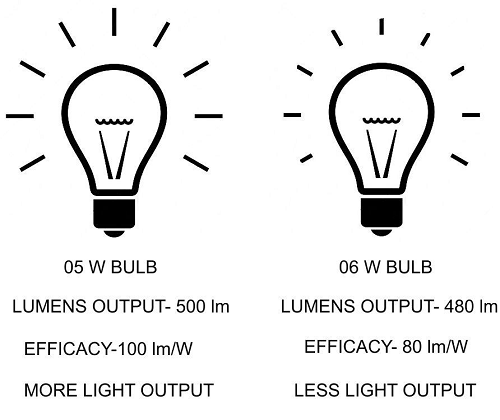
- CCT is measured in degrees Kelvin (K) and indicates what tone of white light will be emitted from the light fixture.
- In order to differentiate the various hues of white, various lighting products are labelled with a correlated color temperature, or CCT.
- Warm white light, refers to a light source with a 2000 to 3000K rating.
- At a temperature of 2000K, the light will look very orange-yellow in color. As the temperature increases, the color shifts to yellow, yellowish white, cool white and then to a bluish white.
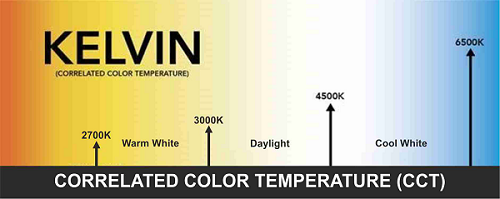
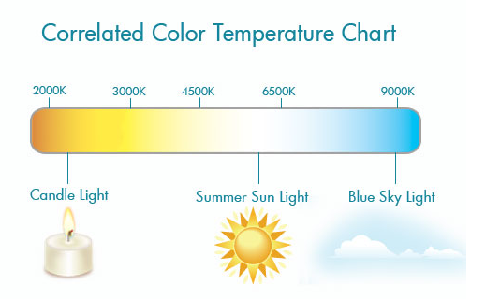
- Color Rendering refers to the way we see the color of an object when a light source such as in incandescent bulb, LED lamp etc. is shown on that object.
- A light source with good color rendering properties refers to lights which accurately illuminate the color of the object
- The highest CRIvalue is set to 100.
- All indoor& outdoor products by Samudra LED have a CRI of >80& >70 respectively
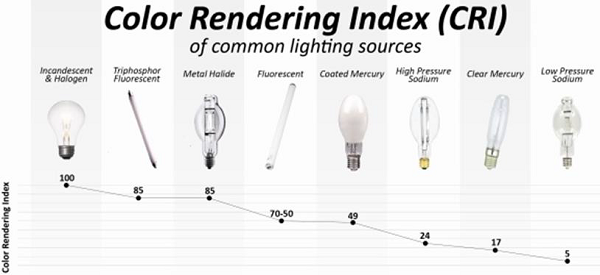
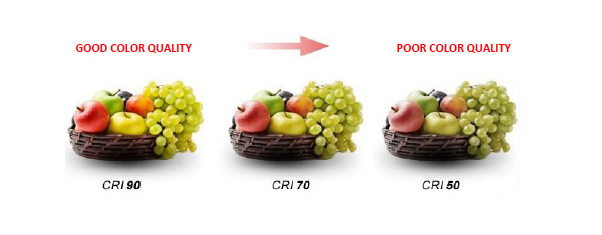
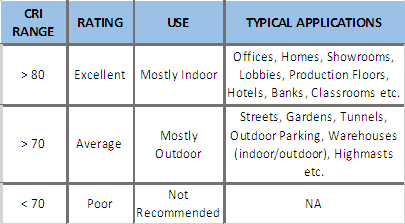
- In simple terms, Efficacy means Efficiency.
- In lighting terms, it translates to the lumen output for per watt consumed.
- Higher the lumen output for per watt consumed, higher the efficacy of the product.
- A high efficacy product ensures high energy savings.
- Samudra manufactures High Efficacy LED products. Samudra LED street lights have an efficacy that ranges between 120 lm/W and 135 lm/W.
- By Efficacy we mean the entire product efficacy and not just the led efficacy.





